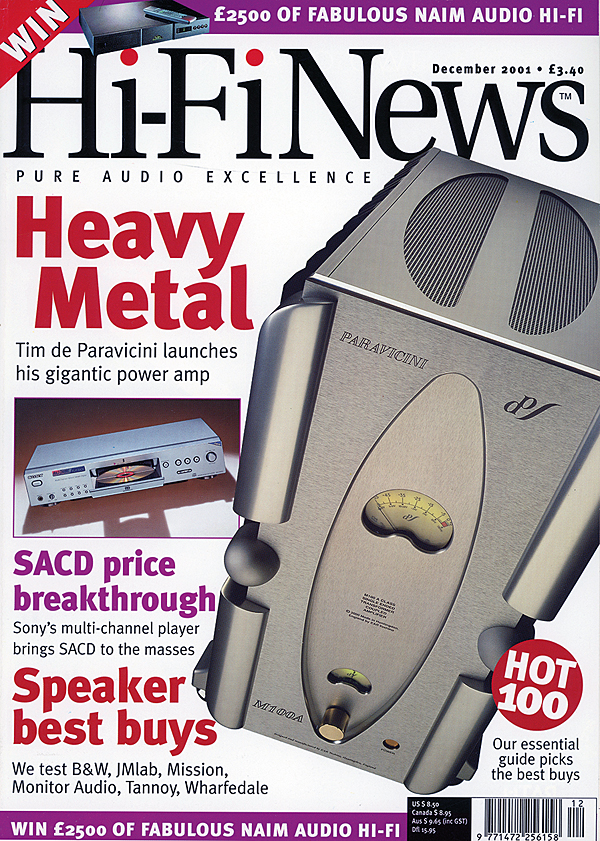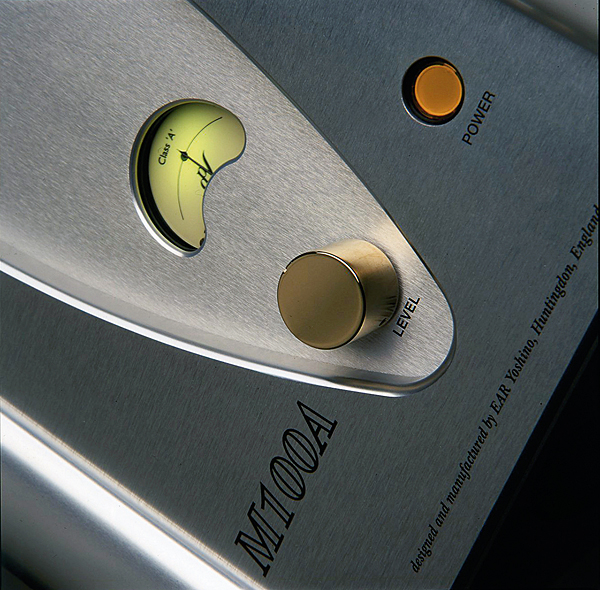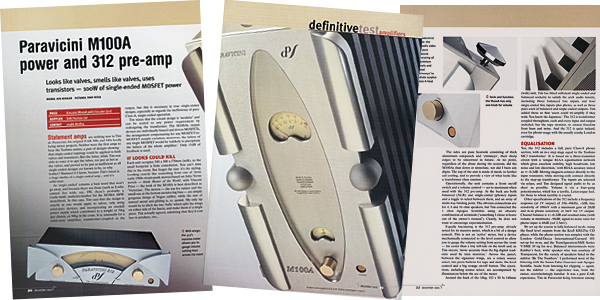Paravicini 312 Preamp and M100A Monoblocks

 Looks like valves, smells like valves, uses transistors – Ken Kessler hears 100W of single-ended MOSFET power from the pen of Tim de Paravicini
Looks like valves, smells like valves, uses transistors – Ken Kessler hears 100W of single-ended MOSFET power from the pen of Tim de Paravicini
Statement amps are nothing new to Tim de Paravicini, his original EAR 509s and 549s hardly being minor projects. Neither were the first amps to bear the Yoshino names, a pair of designs showing that single-ended topology could be applied to both valves and transistors. But the latter, while Tim was able to voice it to ape the tubes, ran just as hot as the valves, and proved just as inefficient as all single-ended designs are known to be, so why bother? Damned if I know, for Tim's latest is a huge mutha of a single-ended amp... and it's solid-state.
Since 'single-ended' remains a buzzword that won't go away, and as there are those (such as I) who cannot live with, say, 8W, there's probably a ready-made market for the M100A 100W monoblock. In this case, Tim says that the design is exactly as one would apply to valves, only using solid-state devices, and incorporating an overkill power supply which contributes to a weight of 70kg per chassis.
Scale Model
Unusually for a solid-state amplifier, the M100A is transformer-coupled at the output, but this is necessary in most single-ended designs, especially as regards the inefficiency of this specific mode of pure Class A operation.

Tim states that the circuit design is 'modular' and can be scaled to any power requirement by redesigning the transformer. The M100A's output devices are individually biased and driven MOSFETs, the arrangement compensating for any MOSFET-to-MOSFET sample variation. What's more, the failure of any single MOSFET would be 'unlikely to precipitate the failure of the whole amplifier'. Only 15dB of feedback is used.
Each unit occupies 240x570x500mm (whd), so the small footprint is little consolation. You can't miss this in the room. But forget the size: it's the styling. Looking like something from one of those 1960s steam-punk movies based on Jules Verne novels – think Master Of The World, with Vincent Price – the look of the M100A is best described as 'Victorian'.
Massive Meter
The meters – the top for output and the small one at the bottom monitoring bias – are simply gorgeous things of Nagra calibre, while the mix of natural metal and gilding is, er, quaint. My only tip would be to ditch the two 'balls' which split the wings on either side of the amplifier's fascia, and make them of a single piece. Tim actually agreed, admitting that they'd cost less to produce, too...
The sides, meanwhile, are pure heatsink consisting of thick aluminium sidepanels and 'chimneys', their sharp edges to be smoothed in future. At no point, regardless of the abuse during the sessions, did the pair of M100As used shut down or immolate, nor did I burn any digits. The top of the unit is made of mesh, to further aid cooling, and to provide the user with a view of what looks like a transformer class reunion.

Operationally, the unit contains a front on/off switch and a volume control – set to maximum when used with the 312 preamp. At the back are both balanced (XLR) and single-ended (phono) inputs and a toggle to select between them, and an array of multi-way binding posts. The obvious connections are for 4, 8 and 16ohm speakers, but Tim connected the 1ohm Apogee Scintillas using an obscure combination of terminals ('something I chose to leave out of the owner's manual', he said). Clearly, he does not want to encourage experimentation.
Equally fascinating is the 312 preamp, already noted for its massive meter, which is a bit of a design conceit. This is not an 'active' meter, but a device mechanically connected to the level control to allow you to gauge the volume setting from across the room – far easier than a tiny tell-tale on the knob and, says Tim, more accurate than the big digital readouts used by rivals that shall remain nameless.
Audio Lunatic
Across the panel, between the signature wings, are a rotary source select, two press buttons for tape and mute, the level control and a big orange on/off button. The operations, including source select, are accompanied by illumination below the arc of the meter.
Around the back of the 18kg, 432x140x305mm (whd) unit, Tim has fitted sufficient single-ended and balanced socketry to satisfy the arch audio lunatic, including three balanced line inputs and four single-ended line inputs plus phono, as well as three pairs each of balanced and single-ended outputs. Tim added these so that 'users could tri-amplify if they wish. You know the Japanese'.

The 312 is transformer coupled throughout, each and every input and output included, bar the tape monitor, to ensure freedom from hum and noise. And the 312 is quiet indeed, even for phono usage with the usually cranky London cartridge.
Inner Ear
Yes, the 312 includes a full, pure Class A phono section, with an MC step stage equal to the Yoshino MC3 transformer. It is based on a three-transistor circuit with a 'unique RIAA equalisation network which gives excellent stability, high headroom, low noise and low distortion', with RIAA accuracy stated as ±0.3dB. MMs connect directly to the input transistor, while moving-coils connect directly to the step-up transformer. The inputs are selected via relays, and Tim designed signal paths to be as short as possible. The volume control, meanwhile, is via a four-gang potentiometer, which has a terrific, Leica-esque feel.


















































